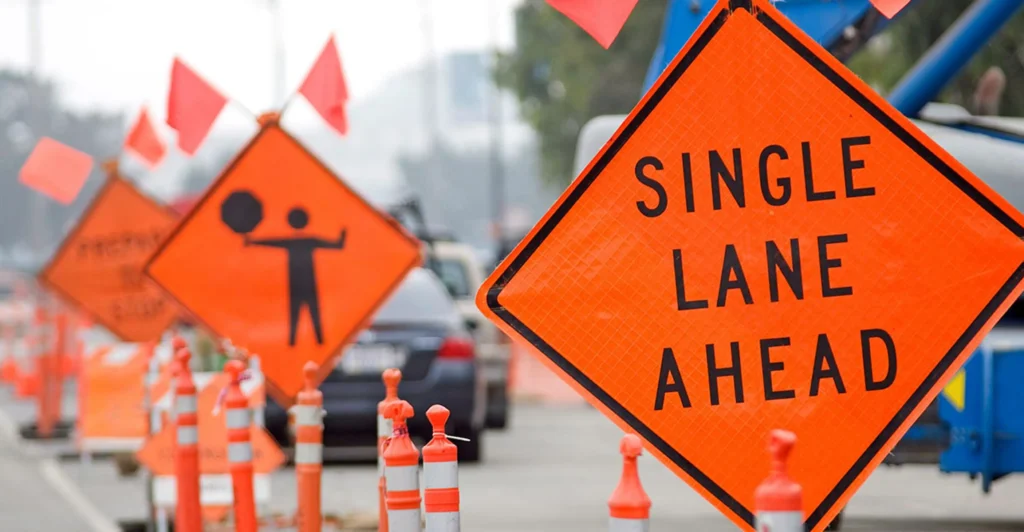Managing traffic near construction sites is not just about keeping vehicles moving. It’s about ensuring the safety of everyone involved—drivers, pedestrians, and construction workers alike. Poorly managed traffic around construction zones can lead to dangerous accidents, injuries, and even fatalities. Implementing proper traffic management strategies, including hiring professional law enforcement, can make a crucial difference in preventing these incidents and saving lives.

The Importance of Traffic Management in Construction Zones
Construction zones are inherently hazardous areas. Workers operate heavy machinery, and the environment is often filled with unexpected obstacles, limited visibility, and frequent changes in road conditions. Add in the unpredictable behavior of drivers, and you have a recipe for potential disaster. This is where effective traffic management comes into play. When managed properly, traffic control measures reduce confusion and maintain a smooth, safe flow of vehicles, preventing dangerous situations from arising.
At the core of traffic management is the protection of both workers and the public. Construction sites disrupt normal driving patterns, and without clear direction, drivers may make erratic decisions—leading to collisions with equipment, workers, or other vehicles. Properly trained personnel, such as law enforcement officers, can guide traffic safely through these areas, reducing the risk of accidents.
How Traffic Management Keeps Workers Safe
Construction workers are particularly vulnerable in roadwork zones. Often, they are working just a few feet away from speeding cars and trucks. In fact, statistics from the Occupational Safety and Health Administration (OSHA) indicate that one of the leading causes of construction fatalities is being struck by a vehicle. By implementing traffic control measures like detours, reduced speed limits, and clear signage, traffic management can drastically reduce the risk of such accidents.
Police officers stationed at construction zones can take these safety measures a step further. Their visible presence encourages drivers to be more cautious and attentive, significantly lowering the risk of accidents. Officers can also stop or slow traffic as necessary to allow construction work to proceed safely, especially when workers need to operate close to moving traffic.
In addition to enforcing speed limits and other traffic regulations, law enforcement personnel are trained to react quickly in case of an emergency. Should an accident occur, having an officer on-site ensures that help is called immediately, potentially saving lives by reducing emergency response times.
Preventing Driver Confusion and Accidents
Drivers are creatures of habit, and construction zones disrupt their usual routes and routines. Unexpected lane closures, detours, or changes in traffic signals can confuse even the most experienced drivers. In the confusion, drivers might make dangerous maneuvers, such as swerving into closed lanes or missing important warning signs.
Effective traffic management provides clear, consistent guidance to drivers as they approach and navigate construction zones. This can include physical barriers, cones, and signs, as well as human intervention in the form of flaggers or police officers. By ensuring that drivers have the information they need well in advance, traffic management helps them make safer decisions and reduces the likelihood of accidents.
Police officers are especially effective at preventing driver confusion because they can adjust traffic patterns in real-time based on changing conditions. For example, if traffic starts to back up due to a lane closure, an officer can step in to direct vehicles and ease congestion, preventing accidents that might occur in a bottleneck situation.
The Role of Law Enforcement in Traffic Control
While temporary traffic signals and automated systems can help direct vehicles in construction zones, they cannot replace the real-time decision-making capabilities of a trained police officer. Law enforcement officers bring a level of authority and flexibility to traffic control that other measures cannot.
For instance, police officers can quickly identify and respond to drivers who are disobeying traffic laws, such as speeding through a work zone or ignoring signage. Their presence alone serves as a powerful deterrent to reckless driving. Officers can also step in to direct traffic during peak hours or when unexpected complications arise, such as equipment malfunctions or severe weather that makes the construction zone more dangerous.
Moreover, police officers are trained to handle emergencies that might occur within or near a construction zone. If a serious accident happens, they are already on-site to manage the situation, secure the area, and coordinate with emergency services, minimizing the risk to others.
Protecting Pedestrians and Cyclists
Traffic management isn’t just about cars and trucks—pedestrians and cyclists are also at risk near construction zones. In areas with heavy foot traffic or bike lanes, construction can create confusion about where people can safely walk or ride. Without clear guidance, pedestrians and cyclists may inadvertently enter hazardous areas or get too close to construction activities.
Proper traffic management ensures that there are designated pathways for pedestrians and cyclists to navigate around construction zones safely. This often involves creating clear detours, setting up physical barriers, and placing visible signs that direct people away from dangerous areas. In some cases, police officers may be stationed at intersections or busy roadways to help pedestrians and cyclists cross safely or reroute them to safer paths.
Reducing the Risk of Roadway Hazards
Construction sites can create additional hazards on the road, such as debris, uneven surfaces, and poorly marked detours. These hazards can lead to accidents, particularly if drivers are not expecting them or if they are not clearly marked. Traffic management plays a crucial role in identifying these risks and addressing them before they lead to incidents.
By setting up advance warning signs and barriers, traffic management teams can alert drivers to the presence of these hazards, giving them time to slow down or change lanes. Additionally, police officers can provide immediate feedback to construction crews if a particular hazard is causing confusion or posing a risk, ensuring that it is addressed quickly.
In some cases, officers may also stop traffic temporarily to allow construction workers to clear debris or make necessary adjustments to the road, further reducing the risk of accidents.
How Traffic Management Saves Lives Beyond the Construction Site
Effective traffic management does more than just keep the construction zone itself safe—it has broader implications for the surrounding community. When traffic is properly managed, the likelihood of accidents in the vicinity of the construction zone decreases, leading to fewer injuries and fatalities.
For example, if traffic congestion spills out beyond the construction zone due to poor management, it can lead to rear-end collisions, aggressive driving, and even road rage incidents. By ensuring that traffic flows smoothly and safely through the area, traffic management helps prevent these secondary accidents, protecting everyone on the road.
Moreover, reduced accidents near construction sites mean fewer disruptions to emergency services, which might otherwise be called to the scene of an accident. This ensures that these services remain available for other critical emergencies, contributing to overall community safety.
Conclusion
Traffic management is not just an afterthought when it comes to construction zones—it is a vital part of ensuring the safety of workers, drivers, and pedestrians. Through clear signage, the strategic use of barriers, and the presence of law enforcement officers, traffic management can prevent accidents, reduce confusion, and save lives. Particularly when police officers are involved, the level of safety increases, as they bring expertise in handling traffic control and emergency situations.
For any construction project, especially those that impact roadways, investing in proper traffic management is a decision that pays off in both lives saved and accidents prevented. With the right traffic control measures in place, construction zones become safer environments for everyone involved.
FAQ’s
How does traffic management improve construction site safety?
Traffic management is crucial for construction site safety because it reduces the risks posed by altered traffic patterns and nearby work zones. By implementing clear signs, barriers, and reroutes, traffic management ensures that drivers are aware of changes ahead, allowing them to adjust their speed and behavior accordingly. Proper traffic control helps prevent accidents involving workers, vehicles, and pedestrians, creating a safer environment for everyone. Additionally, traffic management reduces confusion that might lead to unsafe driving decisions, protecting both workers and the public from harm.
What role do police officers play in traffic management at construction sites?
Police officers play a critical role in traffic management at construction sites by actively controlling the flow of vehicles and ensuring that traffic laws are followed. Their visible presence encourages drivers to slow down and obey posted speed limits, reducing the likelihood of accidents. Officers are trained to direct traffic, handle unexpected situations, and quickly respond to emergencies. This real-time decision-making capability ensures that construction activities proceed safely without risking the well-being of workers or drivers. Officers also act as a deterrent to reckless driving and help manage complex traffic conditions, particularly during peak hours.
Why is driver behavior important in construction zones?
Driver behavior is key to maintaining safety in construction zones because reckless or distracted driving can lead to severe accidents. Construction zones often involve narrow lanes, sudden lane closures, and slower speeds, all of which require drivers to be extra cautious and attentive. When drivers fail to adapt to these changing conditions—whether by speeding, ignoring signs, or failing to yield—they put both themselves and construction workers at risk. Proper driver behavior, such as slowing down, following detours, and staying alert, is essential to preventing accidents and ensuring smooth traffic flow through the zone.
How can traffic management reduce pedestrian accidents near construction zones?
Traffic management reduces pedestrian accidents near construction zones by creating clear, safe pathways for people to walk through or around the work area. Barriers and signage are often set up to direct pedestrians away from hazardous zones, while marked crosswalks or detours ensure they stay out of the way of heavy machinery and vehicles. In areas with high foot traffic, police officers may be stationed to guide pedestrians across busy streets or intersections safely. These measures help prevent pedestrians from accidentally entering dangerous areas and reduce the likelihood of them being struck by vehicles or construction equipment.
Is traffic management necessary for all construction projects?
Yes, traffic management is necessary for most construction projects, especially those that impact roadways or pedestrian pathways. Without proper traffic control, construction zones can become chaotic, leading to accidents, confusion, and delays. Even in smaller construction projects, traffic management ensures that drivers, cyclists, and pedestrians navigate the area safely without interfering with ongoing work. For larger projects, especially those on busy streets or highways, effective traffic management is essential to minimizing disruptions, protecting workers, and maintaining a safe environment for the general public.
What are the benefits of hiring police officers for traffic control at construction sites?
Hiring police officers for traffic control at construction sites offers several benefits. First, their presence adds a level of authority that compels drivers to slow down, follow detours, and respect traffic rules in construction zones. Second, police officers are trained to handle dynamic situations, such as heavy traffic or emergencies, ensuring that traffic flows smoothly even under challenging conditions. Their quick response to accidents or unsafe behaviors can prevent further harm and protect workers. Additionally, police officers provide immediate on-site security, deterring criminal activity, such as theft or vandalism, at the construction site.
Other Related Articles:
- The Importance of Traffic Safety for Road Construction Workers
- How Hiring Police Officers Improves Construction Zone Safety



